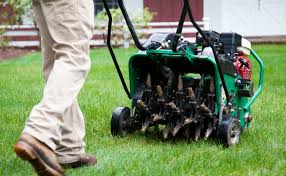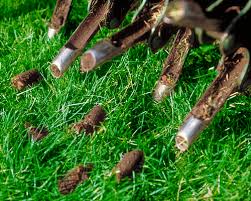Aeration and seeding are one of the most beneficial lawn care services that you can do for your lawn. You may also hear seeding referred as “over seeding”. The optimal window to receive aeration and seeding or over seeding opens at the end of August and runs through the end of October. Warm soils, cool nights and dying annual weeds make fall conditions the ideal time for aeration and over seeding. It is not recommended to aerate and seed your lawn outside of this timeframe. Unlike fall, spring soils are cold and are full of dormant weed seeds ready to grow. In the spring, the competition is fierce as annual weeds want to fight for growing space alongside the new seed. Also, the summer heat can bring trouble for young grass plants that have shallow and tender root systems, which will often become diseased and heat stressed. Many have tried their best only to be defeated, left staring at more crabgrass than lawn come July. With this important service, Green Side Up would like to offer tips for preparing for and the after care of Aeration and Seeding in New Jersey.
Preparing for Aeration and Seeding
.
Mowing
- Mow the lawn one or two days before the day aeration and seeding is to be done — and make it lower than usual. We recommend you set the mowing height to 1-1/2″ (one-and-one-half inches). This will get the lawn low enough without scalping it.
- Mowing low makes both aeration and seeding more effective.
- This will allow the seed to germinate before needing to cut it and sucking the seed up into the mower.
Flag your Sprinkler heads, invisible dog fences and other hard to see objects
- Flag sprinkler heads, in-ground lights, invisible fences, valve box covers, etc. Green Side Up is not responsible for accidental damage to hard-to-see objects in the lawn that are left unmarked.
- If irrigation pipes are shallow (should be 6 inches deep) mark them as well.
- Pay attention to what is just across the property line on your neighbor’s side. Invisible fence and irrigation heads are often installed right along the property line. If you know something might be there, be a good neighbor and tell us about it so no damage is done.
- Flags can be purchased at any home improvement store and are inexpensive.
Devise a watering routine
- If you have underground sprinklers, ensure they are all working. If not, have hoses and above ground sprinklers ready.
- Water the lawn consistently for about a week prior to aeration and seeding. This will soften the ground and allow a deeper core aeration.
- A quick way to know if the soil is moist enough is to push a screwdriver into the soil. If the screwdriver penetrates easily, you are OK.
Clean Up Lawn
- Have debris removed. Toys, leaves, trash cans, furniture etc., this will allow us to completely service the areas you want seeded.
After Care Instructions for Aeration and Seeding
Watering
- Begin watering immediately. Mist water for a few minutes as soon as possible. This will embed the seed where we planted it. It will also give the seed some weight and make it less susceptible to blow or wash away.
- We recommend that you water each day for at least 20 minutes in all areas of the lawn for 3 weeks. Be sure not to over-water to the point that the seed washes away before germination.
- After the third week following seeding, you should continue watering the lawn to keep the soil moist, but not soggy. Decrease watering to 3-4 times per week to maintain moisture for the new seed.
- The main goal is to keep the ground/seed moist while the seed begins to germinate.
Leave aeration plugs alone
- Core aeration will leave plugs of dirt on the lawn. Although this may be unsightly, DO NOT RAKE up the plugs. By removing the plugs, you stop them from contributing critical nutrients and microorganisms to the soil below. It is best to leave them in place.
- The plugs will decompose and filter back into the holes left by the aeration machine.
Minimize the amount of traffic on lawn
- Keep foot traffic, play, and pet activity to a minimum as much as possible.
- By limiting traffic, you offer the seed the best opportunity to properly germinate.
Mowing
- Wait 3 weeks before mowing. The new seedling grass will need to acclimate and set roots before the first mow.
- Once the grass reaches about three to three and half inches, you can mow the lawn for a fresh cut, with the mower set a highest level.
- Prior to mowing, you should discontinue watering for 1 day before mowing to let the lawn dry out.
Remove Fallen leaves as soon as possible
- If leaves remain on the new turf for more than 3 days, the turf will perish.
- Using a leaf blower is the best method of removing leaves, however if you use a rake be careful not to pull up grass seedlings.
Be patient! Germination can take as long as 21 days or longer. Do not stop watering during this period. Seedlings are very susceptible to drying out and dying because they have not rooted into the soil.
If you need any further assistance, please do not hesitate to contact Green Side Up


